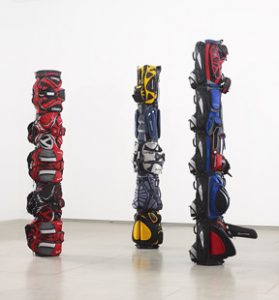Welcome to UBC Blogs. This is your first post. Edit or delete it, then start blogging!
Monthly Archives: September 2016
McLuhan’s The Media Is The Massage
Marshall McLuhan’s “The Media is the Massage” made me feel uncomfortable. I felt like I was being brainwashed with seemingly unconnected and bizarre images while reading McLuhan’s book. However, McLuhan’s book was one of the first pieces of media I have encountered in a long time that I felt was not trying to sell me on a product- although he may have been trying to sell me on an idea. The text’s central idea revolved around this assertion- MuLuhan asserts that the medium by which messaging is being communicated matters more than the content itself. This is further reflected in a quote that is featured on one of the first pages that reads, “The media works us over completely.” It is a statement that speaks strongly to the message McLuhan is trying to communicate that the medium by which content is shared influences our perceptions more than the message itself. In fact, I believe McLuhan that the medium matters so much that I disagree that the title “The Medium is the Massage” was originally printed as a mistake. McLuhan was intentional in the words he chose to explain his assertions, which is illustrated when McLuhan stated, “The media works us over completely. They are so pervasive in their personal, political, economic, aesthetic, psychological, moral, ethical and social consequences that they leave no part of us untouched, unaltered. The medium is the massage” (McLuhan,18). McLuhan was intentional in his use of the words “untouched” and “personal” to amplify his point that the medium is the literal massage and grooming of the mind. His assertions are also revolutionary in that the medium as the primary vessel of communication challenges Western academic norms of black and white blocks of text. Reading this book felt very similar to a screening I saw at the Vancouver Push Festival this year that featured a video montage of strange, seemingly unconnected images of nature with a voiceover of a person speaking words of insight into the human condition. I sometimes found myself so distracted by McLuhan’s voice that I forgot to “look around” and notice the ingrown toenail (McLuhan, 18). This book was meant to be read more than once in order to observe every aspect of it, which is why the pictures and subtle spelling changes are an impactful and disrupting medium to present knowledge. Mediums that ask the audience to figure out what exactly it is trying to tell you are the most effective in my mind.
However, while some of McLuhan’s insights are valid, his discussion of tribal societies is very problematic even for his time. His conception of a romanticized “tribal” society hints strongly of the stereotype of the noble savage. The image printed on page 38 communicates racist notions of what a tribal society should look like (McLuhan, 38).
In Mediacosmology written by Steven Loft, Loft acknowledges that while problematic, McLuhan is able to demonstrate great insight into “The Indigenous Imagination” and cosmology. Loft write that McLuhan states, “The function of art in a tribal society is not to orient the population to novelty but to merge it with the cosmos. Value does not inhere in art as object but in its power to educate the perceptions” (Loft, 181). Loft’s discussion of art reminded me of this image that I came across in another class of golf bags that are stacked on each other to resemble Totem Poles that was created by Brian Jungen: 
This is an excellent example of resistance to how capitalism and colonialism have disregarded Indigenous rights to land by preventing the land and it’s people from merging with the cosmos by building golf courses. The medium by which Jungen’s art was communicated is also similar to McLuhan’s medium because they both disrupt and challenge the everyday, with Jungen challenging the everyday trials of colonialism.
Ultimately, while McLuhan has his faults as we should be cautious laying his work as a foundation for our course, the basic sentiment of the medium as mattering is still relevant today. McLuhan asks his audience to get creative in a way many academics don’t, which makes his messaging all the more effective.
References:
Jungen, Brian. Deconstructed Totem Pole. Accessed Sep 25 2016. Web. URL: https://www.ago.net/assets/images/555/1960-1970-1980.jpg
Loft, Stephen. “Mediacosmology.” Coded Territories. Calgary: University of Calgary Press, 2012. Print.
McLuhan, Marshall, Quentin Fiore, and Jerome Agel. The Medium Is The Massage. New York: Bantam Books, 1967. Print.